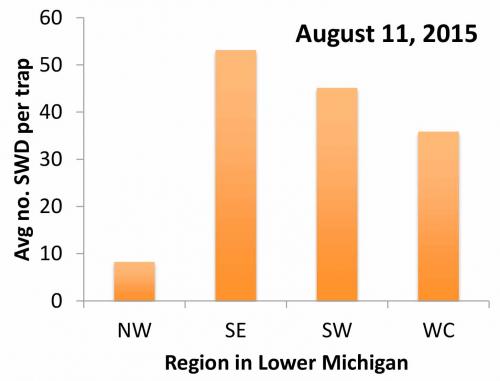Michigan spotted wing Drosophila report for August 11, 2015
High pressure from spotted wing Drosophila is continuing in some areas. Maintain protection of susceptible crops.
The summer increase of spotted wing Drosophila (SWD) continues with 96 percent of all sites in the Michigan State University Extension SWD monitoring network reporting SWD in traps this week. The highest per trap average came from the southeast region this week with southwest not far behind (see the first graph below). There were 1,001 females and 1,982 males for a total of 2,983 SWD captured in 113 traps out of the nearly 120 traps that are being monitored as part of the network this week. This is a 47 percent increase over last week’s numbers. This suggests all regions of the state are at high risk from SWD infestation if you are growing a susceptible crop.
The message to growers is the same as last week: It is essential to maintain fruit protection on ripe or ripening fruit that are susceptible to prevent this increasing pest pressure resulting in larval infestation of that fruit. Maintain coverage with an effective insecticide and do not stretch your spray intervals too far. Also, be sure to reapply after rain because otherwise the fruit will then be unprotected. Thin-skinned fruit, particularly cherries, blueberries and raspberries, are at high risk of being infested and need to be protected. Consult MSU’s Spotted Wing Drosophila website where there are crop recommendations posted for berry crops.
A salt test will help determine whether protective measures are working or if your management program needs to be adjusted. It is advisable to sample fruit before they are harvested. For instructions on how to conduct a salt test, please refer to the July 28 SWD report.
For instructions on how to construct your own traps and use them for monitoring for SWD, please visit the MSU Spotted Wing Drosophila website. For specific recommendations about managing SWD in berry crops, please see “Increase of spotted wing Drosophila in berry crops.”
This is the ninth weekly report of the Michigan State University Extension spotted wing Drosophila (SWD) monitoring network. Traps in the network are baited with Trece lures and placed near susceptible crops and wild hosts in each of the major fruit growing regions across the state. Commercial plantings include strawberries, blueberries, raspberries, grapes, tart and sweet cherries, peaches and plums. Wild hosts in the trapping network include autumn olives, black cherries, pin cherries, choke cherries, blackberries, honeysuckle, mulberries and wild grapes.

Average number of spotted wing Drosophila flies caught in traps in four Michigan fruit production regions. This week: NW = 62 traps in Antrim, Benzie, Grand Traverse, Leelanau and Manistee Counties; SE = 8 traps across Ingham, Lenawee, Livingston, Macomb, Monroe and Oakland; SW = 35 traps across Allegan, Berrien, Kalamazoo, Ottawa and Van Buren; and WC = 12 traps in Ionia, Kent and Oceana.

Average number of spotted wing Drosophila (SWD) captured per trap (red bars) and the percentage of traps that captured any SWD (blue line) across the entire trapping network by week starting in June 30, 2015.



 Print
Print Email
Email




